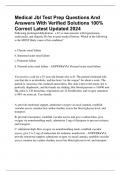Medical Jbl Test Prep Questions And
Answers With Verified Solutions 100%
Correct Latest Updated 2024
Following prolonged dehydration , a 67 yo man presents with hypotension,
tachycardia, and oliguria. He has no past medical history. Which of the following
is the MOST likely cause of his condition?
a. Chronic renal failure
b. Intrarenal acute renal failure
c. Postrenal failure
d. Prerenal acute renal failure - ANSWER✔✔d. Prerenal acute renal failure
You receive a call for a 55-year-old female who is ill. The patient's husband tells
you that she is an alcoholic, and has been "on the wagon" for about a week. The
patient is conscious, but confused and restless. Her skin is hot to the touch, she is
profusely diaphoretic, and her hands are shaking. Her blood pressure is 180/90 mm
Hg, pulse is 120 beats/min, respirations are 24 breaths/min, and oxygen saturation
is 98% on room air. You should:
A: provide emotional support, administer oxygen via nasal cannula, establish
vascular access, monitor her cardiac rhythm, assess her blood glucose level, and
transport.
B: provide reassurance, establish vascular access and give a saline bolus, give
oxygen via nonrebreathing mask, administer 5 mg of diazepam to prevent seizures,
and transport.
C: administer high-flow oxygen via nonrebreathing mask, establish vascular
access, give 2 to 5 mg of midazolam for sedation, monitor her - ANSWER✔✔A:
provide emotional support, administer oxygen via nasal cannula, establish vascular
access, monitor her cardiac rhythm, assess her blood glucose level, and transport.
,A man was trapped in his burning house for approximately 15 minutes before
firefighters rescued him. He reports burning in his throat and a severe headache.
He has a blood pressure of 180/90 mm Hg, a pulse rate of 120 beats/min, and
labored respirations of 28 breaths/min. In addition to providing supplemental
oxygen, treatment should include:
A: amyl nitrite inhaled in 20-second increments.
B: rapid transport to a local hyperbaric facility.
C: IV administration of 1 mL/kg of ethyl alcohol.
D: a slow infusion of sodium nitroprusside. - ANSWER✔✔A: amyl nitrite inhaled
in 20-second increments
Which of the following patients is at greatest risk for suicide?
A: A woman whose mother committed suicide
B: A man who owns multiple guns and knives
C: A woman whose depression acutely improves
D: A man who has not slept for over 72 hours - ANSWER✔✔C: A woman whose
depression acutely improves
Diarrhea, marked bradycardia, miosis, and hypersalivation are MOST consistent
with a/an _____________ toxidrome.
A: amphetamine
B: sympatholytic
C: cholinergic
,D: opiate - ANSWER✔✔C: cholinergic
Cholinergic - relating to or denoting nerve cells in which acetylcholine acts as a
neurotransmitter.
Acetylcholine - a compound which occurs throughout the nervous system, in
which it functions as a neurotransmitter.
Opiate (narcotic symptoms:
-bradycardia, respiratory depression, hypotension, pupillary constriction
Sympatholitic (ie, alpha or beta blocker) toxicity symptoms:
-bradycardia, hypotension, and hypoglycemia
Amphetamine (upper) toxicity symptoms:
-restlessness, pupillary dilation, tachycardia, hypertension, tachypnea, insomnia
Which of the following drug overdoses could be reversed with the administration
of naloxone?
A: Midazolam
B: Phenobarbitol
C: Adderall
D: Meperidine - ANSWER✔✔D: Meperidine
, A known heroin abuser is found unresponsive by a law enforcement officer. Your
primary assessment of the patient, a 24-year-old female, reveals that she is
unresponsive, is breathing at a rate of 6 breaths/min and shallow, and has a pulse
rate of 40 beats/min and weak. You should:
A: ensure that her airway is clear and begin assisting her ventilations.
B: administer high-flow oxygen, start an IV, and give her atropine.
C: begin immediate cardiac pacing to increase her heart rate.
D: intubate her trachea, start an IV line, and give her naloxone. - ANSWER✔✔D:
intubate her trachea, start an IV line, and give her naloxone.
Which of the following ECG abnormalities is associated with hypothermia?
A: Flat T waves
B: Osborn wave
C: Sine wave
D: Peaked T waves - ANSWER✔✔B: Osborn wave
After being stung by a hornet, a 34-year-old man is unresponsive, has stridorous
respirations, a generalized rash, and swelling to the face and neck. His BP is 70/44
mm Hg, his pulse is 140 beats/min and thready, and his respirations are 36
breaths/min and labored. Which of the following represents the MOST appropriate
treatment for him?
A: Bag-mask ventilation and 0.3 to 0.5 mg of epinephrine 1:1,000 SC
B: Blind nasal intubation and 3 to 5 mg of epinephrine 1:10,000 IV or IO
C: Orotracheal intubation and 0.1 mg of epinephrine 1:10,000 IV or IO




